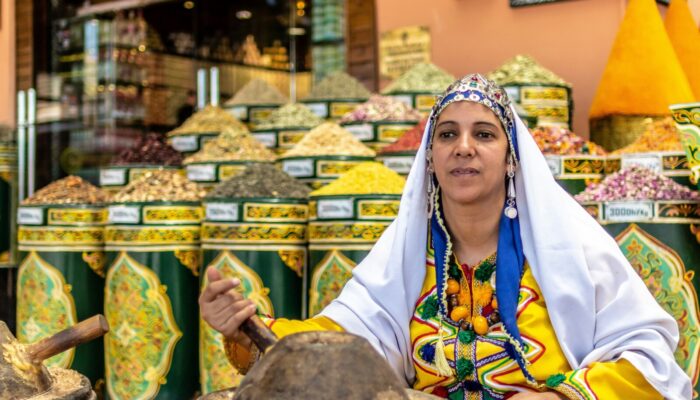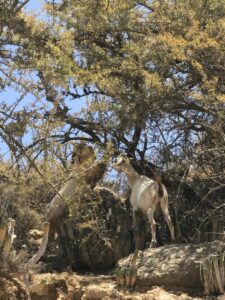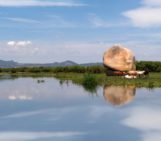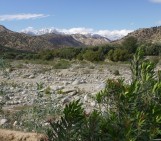
The International Day of the World’s Indigenous Peoples, observed each year on August 9, seeks to raise awareness and protect the rights of indigenous communities around the globe. To honour this, I have invited a few guest authors to write a series of blog posts that celebrate indigenous knowledge and highlight the intersection of natural hazards and climate issues, and resilience, across various indigenous groups worldwide. Today’s blog post is about the indigenous people of North Africa, known as the Amazigh, or Berbers. The author brings an intersectional perspective with a focus on Amazigh women’s experiences in Morocco.
Preservation of traditional knowledge, language and culture
As a proud Amazigh woman, I am delighted to share insights into the climate resilience practices of the indigenous peoples of North Africa, with a focus on the Amazigh communities of Morocco. The Amazigh, also known as Berbers, are the original indigenous inhabitants of Morocco. Most Amazigh communities live in mountainous or desert regions, ecosystems characterized by scarce natural resources. These communities have developed exceptional resilience to both hot and cold weather, relying on minimal water and energy resources. They also demonstrate a strong capacity for preserving their cultural practices and customs like traditional weddings and religious celebrations, and their identity, including their languages and bravery.
In Morocco, different tribes and tribal groups are inhabiting different regions, the three dominant Amazigh groups in the country are the Riffians, the Zayanes, and the Cheluh/Shilhah. As a matriarchal society historically, the woman, especially the mother figure in the traditional Amazigh society, holds until today a pivotal role. As the pillar of the family and the Amazigh community, Amazigh women, are very well-respected guardians of ancestral knowledge, through their mother tongue, they transmit their roots, values, and identities through different generations. My great-grandmother is an example, she is the first in any family gathering to celebrate anniversaries of newborns, weddings, and religious holidays. She is a respected reference for information on the preparation of old dishes that include different types of organic bread cooked with a diverse range of organic seeds. She is also known for sharing stories on fighting recurrent famines and dry weather without rain and harvests in the 20th century. Amazigh women, like my great-grandmother, were and are still strong, powerful, and resilient, with values and legacies they keep passing on from one generation to another.
Climate change’s impacts on Amazigh communities in Morocco
Morocco, along with other North African nations, is grappling with escalating desertification. Rainfall has become both less frequent and more intense, resulting in a prolonged decline in vegetation. This reduction in plant cover accelerates soil erosion and creates conditions conducive to hazardous flash floods. According to climate projections by the World Bank, the central and southern regions of Morocco, home to many Amazigh communities, are expected to experience more frequent and severe droughts.
Amazigh women have a crucial involvement and influence in the management and use of natural resources, community health, and the preservation of biodiversity. As guardians of the Berber food model, they play a significant role at various stages of the crop production cycle: (i) selecting varieties of cereals, fruits, and pastures resistant to drought; (ii) maintaining healthy plants through hand weeding, pruning, grafting, and other techniques; and (iii) handling postharvest activities, such as bringing goods to the weekly market, and preserving seeds and dried fruits. This preservation is often done underground or in specific containers that provide resistance to insects and diseases, allowing them to withstand harsh weather conditions in mountainous and desert regions.
Beyond agricultural production, Amazigh women perform multiple roles to ensure food security for their families and tribes. They are pivotal in maintaining traditional knowledge and practices that contribute to sustainable living and the resilience of their communities. Their expertise in biodiversity and resource management not only supports their immediate households but also helps in preserving the ecological balance and the cultural heritage of the Amazigh people. Among numerous tasks, Amazigh women sew and harvest agricultural products, rear poultry and cattle, fetch water, and gather firewood. They also process wool for clothing and textiles, and transmit their expertise about medicinal plants, cultivars, seed selection, and conservation.
My experiences as a child in our family apple farm in Midelt, which is located between the Middle and High Atlas, are strong and vivid memories that I cherish fondly. I remember these resilient practices by the Amazigh community: They used shrubs and forest wood as sources of energy for heating and cooking during the cold winter, fetched and drank fresh water from wells on the farm, and continuously utilized medicinal herbs and organic honey with healing properties and various benefits for the immune system. These traditional practices highlight the vital role of Amazigh women in sustaining their communities. Their knowledge and skills in managing natural resources and maintaining biodiversity are indispensable for both the ecological and cultural continuity of Moroccan society.
Sadly, with the ongoing climate crisis, many of these practices are progressively disappearing. Continuous droughts lead to water shortages and ecosystem damage, resulting in the loss of vegetation and fruit trees. This lack of agricultural jobs causes increasing migration of men to urban areas in pursuit of better living conditions to provide for their families, leaving their wives as the heads of the household.
My experiences in Midelt provided both physical and mental benefits. Whenever I visited Midelt, I felt at peace and ease. There is a spirit of tranquillity that nature brings, making you feel rejuvenated and healthy. Eating an Amazigh diet, which includes organic foods and raw fruits, drinking fresh water, and taking morning walks at 5 a.m. with the animals were all factors that made me cherish my time in my childhood town. These experiences highlight the profound impact of traditional practices and a natural lifestyle on well-being. The Amazigh way of life, deeply connected to nature, offers a sense of harmony and health that is increasingly rare in today’s fast-paced world. The loss of these practices due to climate change not only threatens biodiversity but also the cultural and emotional fabric of the Amazigh community.
Empowering Amazigh women: leading the path to a resilient sustainable future
As someone who always enjoyed watching their traditional dances, listening to their music, and practicing their culture—including their healing practices and the continuous use of their medicinal herbs—I admire their active engagement, resilience, strength, and advocacy. Amazigh women are role models in our communities and leaders of sustainability.
As agents of change in our current climate crisis, their initiatives, ongoing efforts, and influence in their communities are invaluable. By transmitting their ancestors’ knowledge, culture, and indigenous practices, Amazigh women have the potential to lead sustainable climate justice initiatives within their communities while promoting and protecting their indigenous identity and human rights. These practices and unique indigenous expertise, passed down to girls in their communities since childhood, have the potential to create a strong and resilient future generation of women. Equipped with expertise and skillsets related to various areas, such as food and agriculture, health and medicine, natural resources management, climate change sustainability efforts, arts, crafts and spiritual practices, Moroccan Amazigh women have long held the ability to safeguard ecosystems, ensuring environmental justice and equity.
One breakthrough for the empowerment of Amazigh women and the promotion of their economic independence is in the region of Essaouira-Agadir-Taroudant. This geographical area is known for its unique Argan trees, which produce both cooking and cosmetic Argan oil. Traditionally, women handpicked, collected, and stored Argan seeds for oil extraction. In the 1990s, the government organized women into Argan oil production cooperatives. These cooperatives manage all steps from collection and storage to oil extraction in modern, well-equipped laboratories adapted for producing both cosmetic and cooking Argan oil. Morocco’s Argan oil is internationally renowned for its numerous natural health benefits, especially in the beauty industry, with most of the production being exported worldwide.
Despite the Moroccan government’s progress and reforms in recent years, Morocco’s remote communities are still suffering the impacts of the current global climate crisis. In this scenario, Amazigh women, as indigenous and rural individuals, face a triple marginalization and discriminatory practices. The intersection of these categories significantly enhances their vulnerability to the impacts of climate change. This vulnerability is rooted in the country’s historical Arabization of the administrative and legal system. Amazigh women in these cooperatives not only contribute to the economy but also play a vital role in preserving their cultural heritage and promoting sustainable practices. Their work in the Argan oil industry is a testament to their resilience and adaptability in the face of adversity.
Reflections:
Strengthening Amazigh women’s resilience and adaptation to the urgent climate crisis means valuing their contributions, ensuring their active engagement, and providing representation and leadership opportunities in decision-making processes. It also involves removing barriers to the critical inclusion of their unique needs and perspectives in the development of mitigation and adaptation strategies. These steps will support their well-being and empowerment, promote their subsistence, and create a path for inclusive indigenous involvement in the use of new green technologies to combat climate change. This approach respects their indigenous culture, expertise, and practices.
Moroccan Amazighs exemplify the ingenuity of indigenous peoples, whose cultures and ancient wisdom have evolved in harmony with the land they continue to cultivate. The Amazigh community showcases a sustainable way of living that respects the Earth, even in the most challenging environments. Embracing the practices of the Amazigh people in the fight against climate change is crucial for Morocco and the world. It signifies a return to our roots and a correction of the misguided attempts to modernize, which have often come at the expense of our nation’s cultural and environmental heritage.





